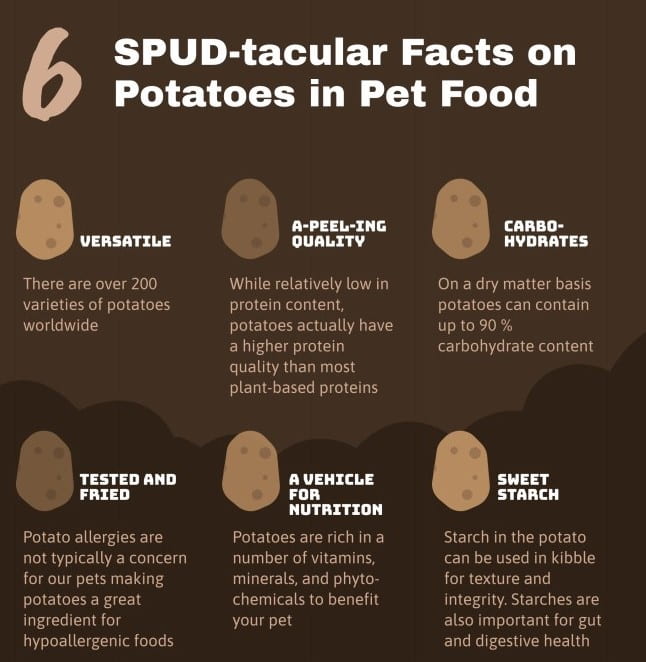
St. Patrick’s Day is around the corner and the celebrations paying homage to Ireland will soon begin! While the majority of these traditions will rely on clovers, leprechauns, pints, and green-themed everything, we also see new recipes popping up favouring the almighty potato. And so, now is a good a time to start the conversation around the use of potato as an ingredient in pet food!
First, a little history on the potato. As a root vegetable, the potato is part of the plant Solanum tuberosum. While many think of Ireland when they hear potato, it was actually first cultivated in Peru around 8 000 BC to 5 000 BC.
It was the Spanish Conquistadors that brought the potato crop to Europe, with Sir Walter Raleigh introducing the potato to the Irish in 1589. Due its success and easy maintenance as a crop, as well as its rich nutrient content, the potato quickly became a staple in human diets.
As for pet food, potatoes have been used in many diets over the years as a beneficial ingredient due to its large nutrient profile such as protein, carbohydrates, fiber, starch, and multitude of vitamins, minerals, and phytochemicals.
The potato is a versatile, and wonderous ingredient that is garnering much attention. Demand for organic, natural, and/or grain-free diets are on the rise, which means potatoes are getting the attention they deserve!
Here we outline some of the benefits of the potato:
- Carbohydrates
Potatoes are well known to be a great carbohydrate source. Carbohydrates are important to include in our pet’s diets as they provide a great energy source. Up to 90 % of the dry weight of a potato can be carbohydrate content. The high carbohydrate content of potatoes makes them a great carbohydrate option in grain-free diets.
- Potato Fiber and Starch
Fiber, while technically a carbohydrate, gets its own section here. Potato fiber, as with many fibers in pet food, can help with glycemic response, improving stool and the microbiome.
Potatoes provide some sources of insoluble fibers such as cellulose and pectin, although the highest dietary fiber content of the potato is in the skins.
Starch is a large component of the carbohydrate content of potatoes. Starch can provide nutritional value for digestive health, specifically in the gut. Starches can also aid in formulation of kibble-based foods by balancing kibble density and expansion or size of the kibbles.
- Potato Protein
While potatoes have a low protein content, the protein quality is considered high for a plant-based ingredient – although it is important to note that potato protein alone does not provide a complete protein source and should be used in combination with other, high protein ingredients to ensure a complete amino acid profile.
- Vitamins, Minerals, and Phytochemicals
Potatoes are such a rich source of vitamins making them a great addition to your pet food.
Vitamin C is probably what potatoes are most known for! While vitamin C is not considered essential for dogs and cats because they can make it themselves, it can be beneficial to include in the diet to obtain some of its amazing benefits! Vitamin C is an antioxidant reducing oxidative stress in the body and overall protecting the body from chronic disease. It can also be great for aiding in the absorption of other nutrients, such as iron. And of course, we all know that Vitamin C plays a significant role in immune health and function.
A mineral with a high concentration in the potato is Potassium which is important for normal cell functions. Potassium in the diet can be beneficial in protein synthesis and carbohydrate metabolism. As with any nutrient, it is important to maintain healthy levels, and avoid deficiency or toxicity.
Polyphenols are a type of phytochemical that encompass a large array of substances that can provide many health benefits. Due to their high antioxidant and anti-inflammatory effects, polyphenols can be used in the fight against pet obesity as well as diabetes prevention and treatment.

While this is by no means an exhaustive list of the benefits of the potato as an ingredient in pet food, it can demonstrate how a controversial ingredient such as the potato, when broken down to its nutrient composition, can be beneficial in pet food.
To read more about the differences between ingredients vs nutrients, check out our other blog post: Understanding Nutrients and Ingredients
As for the controversy of the use of potatoes, this generally stems from the 2018 findings published by the FDA on dilated cardiomyopathy in dogs and its potential connection to grain-free diets. There is still much to evaluate on this topic – a great place to start is this comprehensive article addressing the current gaps in our understanding of this association: Mansilla et al, 2019.
With that we wish you all a safe and fun St. Patrick’s Day weekend! To keep your pet safe during any celebrations, consider reading about toxic foods and things to look out for in our previous blog: Check the List Twice – Find out What’s Naughty or Nice
Written by: Hannah Godfrey, BScH, MSc Candidate
Edited by: Dr. Adronie Verbrugghe, DVM, PhD, EBVS Specialist in Veterinary and Comparative Nutrition® (Dip ECVCN)
REFERENCES:
Ezekiel et al. 2013. Beneficial phytochemicals in potato – a review. Food Res Internat.
Zaheer & Akhtar. 2016. Potato production, usage, and nutrition – a review. Crit Rev Food Sci Nutr.
Navarre et al. 2009. Chapter 14: Nutritional value of potatoes: vitamin, phytonutrient, and mineral content. Advances in Potato Chemistry and Technology.
Panasevich et al. 2013. Potato fibre as a dietary fibre source in dog foods. J Anim Sci.
Domingues et al. 2018. Effect of potato on kibble characteristics and diet digestibility and palatability to adult dogs and puppies. Ital J Anim Sci.
Di Cerbo et al. 2017. Functional foods in pet nutrition: focus on dogs and cats. Res Vet Sci.


